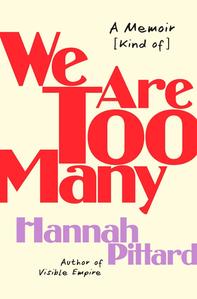
 In We Are Too Many: A Memoir [Kind of], novelist Hannah Pittard (Reunion; Listen to Me; Visible Empire) examines her failed marriage, which cratered with the revelation that her husband, Patrick, was having an affair with her best friend, Trish. In her semi-experimental three-part account, Pittard performs a kind of exploratory character surgery using unorthodox tools and no anesthesia. Reading the book can feel like listening in on an incredibly uncomfortable conversation between two people in the throes of a breakup: the experience is squirm-making, seems a little sordid, and is often thrilling.
In We Are Too Many: A Memoir [Kind of], novelist Hannah Pittard (Reunion; Listen to Me; Visible Empire) examines her failed marriage, which cratered with the revelation that her husband, Patrick, was having an affair with her best friend, Trish. In her semi-experimental three-part account, Pittard performs a kind of exploratory character surgery using unorthodox tools and no anesthesia. Reading the book can feel like listening in on an incredibly uncomfortable conversation between two people in the throes of a breakup: the experience is squirm-making, seems a little sordid, and is often thrilling.
Part One is written like a play: each segment begins with its time and place, followed by an admittedly "imperfectly recollected" dialogue, or else a hypothesized one, as when Patrick and Trish speak on the phone. Typically, the conversations involve Pittard and Patrick as they navigate 10 years together, largely in Lexington, Ky., and Charlottesville, Va. It can be tempting to read this part of the book as score settling gussied up as a literary concern, as the dialogues routinely show Patrick in an appalling light: talking Pittard out of taking a tenure-track job, splurging on lamb chops when the couple is cash-strapped, and so on.
But Part Two, a fantasy two-hander in which Pittard and Patrick have it out, redresses the imbalance by frequently showing her in an unfavorable light; as Pittard puts it, "I was and am hyper neurotic, and I did and do have grotesquely rigid expectations. My own way of being virtually precludes a successful relationship." Here the anger of the book's first part sloughs off and exposes a wound: "I guess what I'm trying to figure out is, whose fault is it?" Pittard says to Patrick at one point. "Mine for changing or yours for not changing?"
Part Three offers autobiography in short chapters that rehash the aftermath of Patrick's affair: he's now married to Trish, and Pittard has a new boyfriend. This part dives into Pittard's complicated childhood, during which she served as a pawn in her parents' 10-year custody battle while she dealt with body image issues that launched a persistent eating disorder. This is the most straight-up of the book's three parts, which could be summarized as, respectively, rage, hurt, and healing. Cumulatively, the parts of We Are Too Many tell the story of heartbreak in perhaps the most scorching, gutting, and tantalizing way imaginable. --Nell Beram, author and freelance writer
Shelf Talker: Novelist Hannah Pittard offers a scorching, gutting, and tantalizing account of her failed marriage, which ended after she learned of her husband's affair with her best friend.

